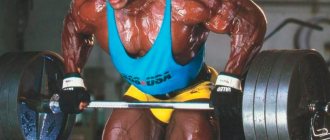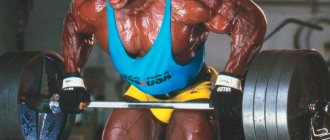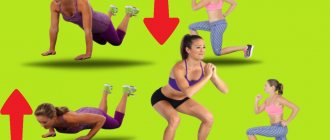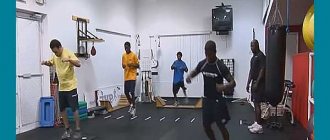As we have said many times before, all ages are submissive to sports. “Iron sport” is no exception to this rule. Just as rapidly as for adults, bodybuilding for children is also gaining popularity. Why not? I suppose it is no secret to anyone these days that modern Champions of athletics and rhythmic gymnastics begin to train their children from the age of 3. After all, to achieve truly real success in these sports, you need to spend decades. And starting classes at the age of 6 is already considered an irreparable lag, doomed to failure...
Of course, no one says that the baby should be immediately placed under a barbell from the cradle and loaded with unbearable weights and Olympic standards! This will definitely be unnecessary, and even harmful to the child’s health. But reasonable, standardized and controlled athletic training, and group training with fun outdoor games, will only have a positive impact on the physical, mental and spiritual state of your baby...
Until recently, the following norms were the acceptable level of sports activity for children:
It is useful for younger schoolchildren to learn how to climb a rope. These exercises are necessary to develop flexibility, dexterity, balance, coordination and softness of movements.
- I) pull-ups on the bar,
- II) flexion and extension of the arms while lying down,
- III) raising and lowering the body in a lying position (hands behind the head, legs secured).
You can include barbell pushes from the chest into special strength training.
Schoolchildren under 14 years of age should be very careful when engaging in strength exercises; their bodies are not yet ready to experience prolonged physical stress.
Nowadays, the view on children's sports has changed somewhat, and along with it, the norms of permissible load have changed towards an increase... But the question is: is it possible to cultivate bodybuilding for children? Or will this be too much?
Athletic training for children.
Strength exercises with preschool children strengthen their health, promote accelerated growth and development, and develop correct posture. By doing athletic gymnastics, children become cheerful and energetic, resilient and strong, dexterous and fast. They tolerate the load well, but you should always remember that it should increase gradually and consistently, and the effect of exercise on the growing body should remain constant. In this case, it is necessary to clearly take into account age and the degree of physical development (as opposed to unorganized and often monotonous motor activity). The total duration of one lesson is different for each age. For children under two years old it is 8 - 10 minutes, from two to three - up to 15 - 20, for older children - up to 30 - 40. To prevent fatigue, change starting positions (sitting, standing, lying) and movements more often, alternating them with rest breaks. You can use dumbbells, sticks, a ball, clubs, bags with weights, etc. as weights. It is necessary to correctly and clearly explain to the child the procedure for performing the exercise. Exercises with an open window, barefoot, are useful.
Important points in creating a workout for children.
When planning physical training for children and choosing exercises for them, it is important to remember that in children 3–6 years old the spinal column is very sensitive to deforming influences, and skeletal muscles are characterized by poor development of tendons, fascia, and ligaments. By the age of 6, a child, as a rule, has well-developed large muscle groups of the trunk and limbs, but small muscles, mainly the hands, are extremely weak. To train children 6-8 years old, exercises should be chosen in such a way that the load is feasible and affects various muscle groups, first of all, proportionally develops the flexors and extensors of the torso; special attention is paid to the development of the balance function.
In the process of targeted exercises with weights, in combination with outdoor games, children acquire the ability to control their movements and differentiate muscle efforts. Thus, they develop the ability to perform exercise movements with various amplitudes and in different modes, which the children can change according to the instructions of the teacher.
When conducting sports fitness training for children, you need to gradually move from relatively simple exercises performed with low amplitude and at a slow pace at 3-4 years of age to more complex ones in coordination, with adjustable amplitude and variable tempo at an older age. Weights during training for children aged 6–8 years are selected extremely carefully and progressively, and at the age of 3–6 years, weights are rather symbolic and are intended mainly to influence the difficult and slowly developed muscles of the arms, especially the flexors of the hand.
Do children need strength training? Isn't this dangerous for a fragile child's body? Without a doubt, it is better for children not to lift heavy dumbbells, just as it is better not to reach for exercise equipment.
The child can perform simple exercises using his own weight. With careful adherence to safety precautions, your child will become stronger, improve his metabolism, learn to control his weight and grow healthy.
Aerobic fitness
In addition to strength training, you can perform aerobic exercises that strengthen your heart, develop endurance, and also help maintain weight. They can be done at any free time and even on strength training days. It is only necessary to perform fitness exercises after a strength complex, otherwise the muscles will already get tired, which will significantly reduce the effectiveness of the training.
It is necessary to start aerobic training with children calmly, but after 5 minutes the intensity can be increased. The elevated pace should be maintained for the next 20 minutes. The last 5 minutes should also be spent in a calm mode, completing classes.
Beginners should train for no more than 15 minutes, and it is necessary to monitor their heartbeat all the time. Your heart rate should be between 65 and 80 percent of your maximum heart rate.
What are the benefits of strength training?
Such strength training for children develops endurance and agility, improves bone mineral density, helps regulate blood cholesterol levels and maintain normal body weight.
If your child is already involved in sports, additional children's strength exercises will help improve results. And so that they do not harm the growing body, it is necessary to follow safety precautions and organize classes correctly.
activesportfitness.co.uk
Safe Strength Training for Children
Regardless of the baby’s age, it is important to remember that the child performs strength exercises correctly and maintains an adequate pace. The child must understand the order of performing the exercises, have sufficient physical training and carefully listen to the instructions of the trainer. Constantly monitor your son/daughter during classes. Don't overload your baby: 2-3 strength training sessions per week is enough. It's not so much the frequency that matters, but the regularity. Give examples of fairy-tale characters, movie and cartoon characters, who are characterized by strength and endurance. Transform yourself into Boniface the Lion, Batman or Superman while training. Watch your favorite films or cartoons with your child and create a workout for a real hero.
If a child attends a sports section, the introduction of strength training must be previously agreed upon with the coach. Consult with him about safety precautions, exercises and training regimen.
Approximate training plan for a child 6-9 years old:
1. Start with a short warm-up (5-10 minutes): brisk walking, jogging in place or jumping rope.
2. To develop the main muscle groups, choose exercises with a gymnastic stick or ball. They are great for training your arms, shoulders, stomach, legs, chest, upper and lower back.
3. Exercises to maintain balance and develop range of motion. One exercise each for the main groups of joints of the arms, legs and spine.
4. Exercises using resistance and body weight. One exercise - 10-15 repetitions: squats, push-ups, pull-ups, lifting legs and torso from a lying position.
5. A little rest and some simple stretching exercises.
Ekaterina Morozova
Reading time: 11 minutes
A A
Some parents consider exercise unnecessary (“why, there’s physical education at school!”), others don’t have an extra 15-20 minutes for their children, “because it’s work!” And only a few mothers and fathers understand the importance of exercise for the child, and specifically get up half an hour early in the morning in order to have time to cheer up together with the child and prepare the body for the school/work day.
If your children sleep in class and are constantly shirking physical education lessons, this instruction is for you!
Advantages of gymnasiums when doing strength training
Some parents believe that the child can perform strength training independently at home. However, the absence of an experienced mentor can reduce all efforts to a minimum. Going to the gym is not only about the active help of a trainer. Other advantages of this solution include:
- availability of modern safe equipment. It helps to expand the exercise cycle. Diverse training can interest a child more and instill in him a love of sports and physical activity. He will go to a well-equipped room with great pleasure;
- opportunity to communicate with peers. This is not only an expansion of the circle of friends, but also a spirit of competition that will stimulate the child to new achievements.
When is the best time for a younger student to do exercises? How to prepare for gymnastics?
Man by nature must move a lot. It’s not for nothing that they say that movement is life. The less a child moves, spending all his free time near the TV, the more health problems he gets.
Children's specialists are sounding the alarm and reminding parents that children's bodies should be actively moving at least 10 hours a week, and for younger schoolchildren this minimum increases to 3 hours a day. Moreover, it is desirable that this happens in the fresh air.
Naturally, parents have too little time, but still dedicating 20 minutes in the morning and 20 minutes in the evening for exercise is not that difficult.
IV complex – bench press with a turn
Here you need to work with your shoulders:
- IP – bend your arms, with the dumbbells located at neck level, with your palms turned inward. The head should always be kept straight, the shoulders should be turned, the gaze should be straight ahead.
- The arms are straightened above the head, and they should be turned so that the palms at the top are facing forward.
- A short pause. Hands down.
During this workout for children 12 years old, you can move your arms slightly back, which will increase the tension in the muscle structure.
The body itself should not move, otherwise the load becomes too great.
How to prepare a child for exercise?
Of course, it’s difficult to get a child out of bed ahead of time, especially “for some kind of exercise.” This wonderful habit must be instilled gradually.
As you know, for a habit to become established, it takes about 15-30 days of regularly repeated actions. That is, after 2-3 weeks of such activities, your child will already be drawn to them.
Without attitude - nowhere. Therefore, the most important thing in forming this habit is to tune in and.
In addition, it is important that the child’s exercises change periodically (children at this age get tired of the same type of training too quickly).
And don’t forget to praise your child and encourage any physical activity in every possible way.
Sports sections for children 5,6,7,8,9,10,11,12,13,14,15,16,17,18 years old boys girls
There are different types of sports, each sport is good in its own way, one of the most popular sports for boys is football, many parents send their children to football! Football is a team sport where the main emphasis on training is so that the child learns to play football correctly, perform feints, in other words, beat other football players with the ball!
From the point of view of the load, the entire training in football is spent on endurance, as in track and field athletics, children always mostly run and do no more than they do any loads with barbells, dumbbells and other equipment, the maximum that a coach can give during a football training is to tell his students on the team need to do push-ups, squats, and jumps no more.
So, here are 15 exercises for younger students:
The first 5 exercises are to warm up the muscles. It is strictly forbidden to do complex exercises immediately after sleep.
- We take a deep breath and rise on our toes.
We pull the handles up as high as possible, as if we are trying to reach the ceiling. We lower ourselves to the full foot and exhale. Number of approaches – 10. - We tilt our head to the left, return to the starting position for a couple of seconds and then tilt our head to the right
. Next, we make circular movements with our heads - to the right side, then to the left. Execution time – 2 minutes. - Now shoulders and arms.
We alternately raise one shoulder, then the other, then both at once. Next, we swing our hands upward - in turn, now with our left hand, now with our right hand. Then make circular movements with your arms, as when swimming – first breaststroke, then crawl. We try to do the exercises as slowly as possible. - We rest our hands on our sides and bend
– left, right, then forward and backward. 5 times - in each direction. - We walk in place for 2-3 minutes, raising our knees as high as possible
. Next, we jump 5 times on the left leg, then 5 times on the right leg, then 5 times on both, and then jump with a 180-degree turn. - We stretch our arms forward, interlock our fingers and stretch forward - as far as possible
. Then, without losing the lock, we lower our hands down and try to reach the floor with our palms. Well, we finish the exercise by trying to reach the ceiling with our clasped palms. - We do squats.
Conditions: keep your back straight, legs shoulder-width apart, hands can be clasped behind your head or extended forward. The number of repetitions is 10-15. - We do push-ups.
Boys, of course, do push-ups from the floor, but for girls the task can be simplified - you can do push-ups from a chair or sofa. The number to repeat is from 3-5. - Boat.
We lie down on our tummy, stretch our arms forward and slightly up (lift up the bow of the boat), and also put our legs together, lifting up the “stern of the boat.” We bend the back as hard as possible. Execution time – 2-3 minutes. - Bridge.
We lie down on the floor (children who know how to lower themselves onto the bridge from a standing position, lower themselves straight from it), rest their feet and palms on the floor and, straightening their arms and legs, bend their back in an arc. Execution time – 2-3 minutes. - We sit on the floor and spread our legs to the sides.
We alternately reach out with our hands to the toes of our left foot, then to the toes of our right. It is important to touch your stomach with your leg so that your body lies with your leg - parallel to the floor. - Bend your left leg at the knee and lift it up, clapping your hands under it
. Then repeat with the right leg. Next, we raise the extended left leg as high as possible (at least 90 degrees relative to the floor) and clap our hands under it again. Repeat for the right leg. - Martin.
We spread our arms to the sides, move our left leg back and, slightly tilting our body forward, freeze in the swallow pose for 1-2 minutes. It is important that the body at this moment is parallel to the floor. Next, we repeat the exercise, changing the leg. - We hold a regular ball between our knees, straighten our shoulders, and rest our hands on our waist.
Now we slowly squat, keeping our back straight and the ball between our knees. The number of repetitions is 10-12. - We rest our hands on the floor and “hover” above it in a “push-up” position.
Now slowly, using our hands, we “go” to a vertical position. We rest a little in the “ostrich” pose and “stomp” our hands forward to the original position. We walk back and forth with our hands 10-12 times.
We finish the exercise with a simple exercise for relaxation: we stretch “at attention” while inhaling, tensing all the muscles – for 5-10 seconds. Then we sharply relax at the command “at ease”, exhaling. We repeat the exercise 3 times.
Complex II – one-handed projectile row while standing in a bent-over position
Now the back gets involved:
- The dumbbell is taken in the right hand, and with the left hand, together with the knee of the same name, rest against the bench. As a result, the body should become almost parallel to the floor. The right arm with the dumbbell is straightened, the palm is turned inward (towards you).
- Then the hand bends, pulling the projectile up and slightly back, to the lower abdomen. A short pause to work the muscles, after which the limb is lowered.
- After performing repetitions on one side of the body, the arm changes.
During this training, children 10 years and older work the back muscles. To stabilize the pose, you should tighten your abdominal muscles and keep them tense all the time. Movements should be smooth, without sudden jerks.
Where to look for this motivation, and how to entice a child to exercise so that the child enjoys it?
- The main rule is to do exercises all together!
Well, if dad categorically refuses, then mom should definitely participate in this process. - We turn on upbeat and cheerful music.
Doing exercises in silence is boring even for an adult. Let the child choose the music! - We are looking for an incentive in each specific case.
For example, an incentive for a girl can be a beautiful, toned figure that everyone will envy, and an incentive for a boy can be muscle definition that he can be proud of. Losing weight if the child is overweight will be no less of an incentive. - We are looking for those we can imitate.
We do not create idols (!), but look for a role model. Naturally, we are looking for him not among bloggers and bloggers with beautiful bodies and emptiness in their heads, but among athletes or heroes of films/movies that the child loves. - Exercise is needed to become stronger.
And you need to be strong (strong) to protect your younger brother (sister). - In addition to 5 exercises to warm up the muscles, you need to choose another 5-7 exercises for direct exercise.
No more is needed for this age, and the workout itself should take no more than 20 minutes (twice a day). But it is important to regularly change the set of exercises so that the child does not get bored! Therefore, immediately make a large list of exercises, from which you will pull out 5-7 new ones every 2-3 days. - We talk with the child more often about health
: why exercise is so important, what it gives, what happens to the body without physical activity, and so on. We are looking for thematic films and cartoons, which we watch, of course, with the child. We often watch films in which young athletes achieve success - often these films become powerful motivators for a child to enter the world of sports. - Set up a sports corner for your child in his room
. Let him have personal parallel bars and rings, a Swedish barre, a fitball, a horizontal bar, children's dumbbells and other equipment. As a reward for each month of training, make it a trip to a trampoline center, play climbing, or another sports attraction. - Use his own preferences to attract your child to exercise
. For example, if a child loves a ball, consider a set of exercises with the ball. He loves parallel bars - do exercises on the children's playground. Etc.
Correct program
Training for children 7 years old should last no more than 30-45 minutes. In this case, at the initial stage it is necessary to use a set of exercises, which include the use of dumbbells and working under the influence of your own weight. While these strength training sessions provide significant benefits, there are certain rules to keep in mind.
This is what the correct program is based on:
- Qualified training - for classes it is worth hiring an experienced trainer who has extensive experience working with children. Depending on the age, skills and interest of the child, a specialist will help create the right training program. As a last resort, almost every city has strength training classes that are designed specifically for children.
- Warm-up and cool-down - before carrying out the main exercises, it is important to accustom your child to warm-up (walking or running in place, jumping rope). This usually takes from 5 to 10 minutes, which allows you to warm up the muscles for further work and avoid injury. In addition, it is important to stretch at the final stage, which is also necessary.
- Correct technique - in training for children, there is no need to focus on the intensity of the load; it is much more important to monitor the correct execution of the exercises. As your child gets older, you can gradually increase the number of repetitions.
- Supervision – Children always need supervision, especially when it comes to strength training.
- Waiting for the result. You shouldn’t expect visible results overnight—you need to explain to your child that everything takes time, so that he doesn’t give up immediately. In addition, the way to interest him has already been described above. In any case, after a few weeks, or maybe even a day of regular training, the child will definitely notice a difference in muscle strength and endurance.
A set of exercises to develop muscles of the whole body
At the beginning of the lesson, it is advisable to “warm up” and stretch all muscle groups. Warm-up lasts 5-20 minutes.
Basic training program:
- 8-15 push-ups on parallel bars (for boys), or from the floor (benches, benches, for girls);
- 5-10 pull-ups on a high or low bar with an overhand grip;
- 8-15 leg raises to the bar or 10-14 straight leg raises in a lying position;
- 5-10 pull- ups with an underhand grip (for boys on a high bar, for girls on a low bar);
- 8-15 push-ups on parallel bars or from a bench;
- 5-8 leg raises to the bar or 8-10 straight leg raises in a lying position;
- 4-8 wide grip pull-ups;
- 10-20 leg raises while lying on your stomach on an inclined gymnastic bench;
- 5-10 jumps up , pushing off with one foot from the bench alternately;
- 10-15 flexions and extensions of the torso , sitting across a bench with legs secured.
What tasks should be set for the teacher?
A teacher is not the person who will force a child, he must instruct, interest, encourage, and tell. At this age, children take everything literally, so they will not be interested in just doing exercises.
If the classes are interesting, then we can consider that half the work has already been done. The next point is, of course, competent management. You can make a thousand plans, prepare thoroughly, but there will be no result due to poor ability to manage children.
The next thing is to try to make sure that children lead a healthy and active lifestyle not only in training and activities, but also at home. Unfortunately, this issue is now much more pressing than it was before. If we used to spend more time outside, the current generation prefers to stay at home and play with various gadgets.
As a result, the child should become physically stronger, improve reaction, speed, endurance and flexibility, without losing his interest. This task is quite difficult, but doable if you strictly follow the plan.











